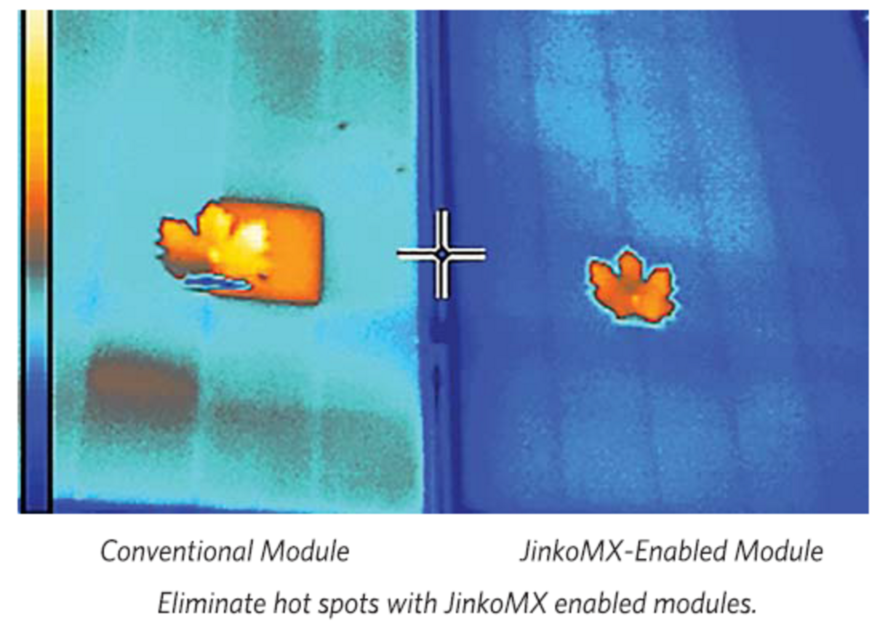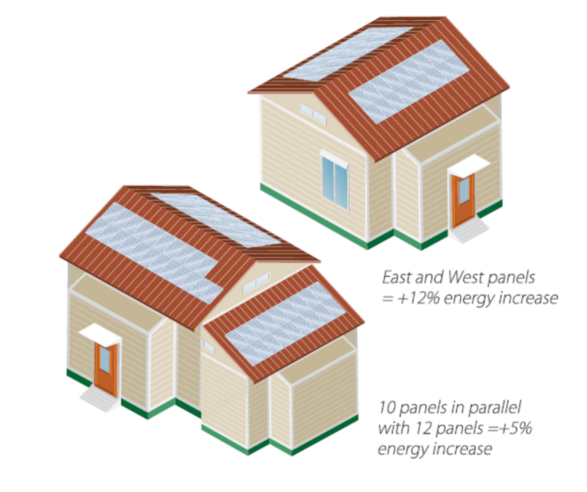Panel manufacturer JinkoSolar claims to have solved the issue of partial shading of solar panels with its new line of JinkoMX modules, which use an advanced power optimisation technology called a ‘cell string optimiser’ by Maxim instead of conventional bypass diodes.
Partial shading and the problem of the ‘weakest link’
With conventional solar PV systems (i.e. ones that use central, ‘string’ inverters), shading on even part of one of the panels can result in a dramatic drop in power output. This is because shading on one panel – or even on one solar cell within a solar panel – essentially blocks the flow of electricity through the rest of that panel, not to mention all the other panels in the same string. This is often referred to as the ‘weakest link’ problem (illustrated in the image below).
The approach of lining solar cells and solar panels up in series (i.e. one after another) using bypass diodes and panels strings is a very cost-effective way to do solar installations. However, the ‘series connection’ approach introduces one serious flaw: the current through all series elements must be the same, so the entire PV string is forced to operate down to the level of the weakest cell strings. In essence, one under-performing cell can limit production of hundreds of other cells. To work around this fundamental limitation, panel manufacturers add bypass diodes in parallel with every cell string, so that severely weakened cells are electrically removed from the circuit instead of degrading the power output of the entire string.
Bypass diodes are a crude yet effective way of preventing system-wide production loss in the face of large mismatch. Jinko points out that bypass diodes have been a limiting factor on module performance for years. as they can cause modules to suffer from power degradation over time due to shading, soiling and other sources of mismatch. Furthermore, these issues can limit system capacity due to row-to-row shading.
Bypass diodes are a safety feature in solar panels that allow electricity to flow around ‘blocked’ shaded cells. However, they come with their share of limitations, including the fact that they can lead to premature cell degradation.
Bypassing the bypass diodes: Greater design flexibility & ease of installation
The cell-string optimizers embedded in JinkoSolar MX modules replace the bypass diode with a single chip integrated circuit from Maxim Integrated, providing better module reliability and the function of a DC Optimiser on each cell string within the module. Installation is the same as a conventional module, as there is no need for additional hardware or boxes to bolt on at the installation site.
Maximum point power tracking (MPPT) is performed at the cell string level. By replacing each diode with an MPPT tracking device, the on-off response to performance mismatch is eliminated. Each cell string contributes maximum power without interfering with the power production capability of the others. This enhanced degree of flexibility leads to increased energy production, eliminating performance loss due to module mismatch, degradation, soiling, localised shading, and row shading loss mechanisms.
The JinkoSolar MX module keeps options open for an installer. Installers can mix and match panel orientations, module power ratings, and may even use unequal string lengths in parallel – all without compromising energy yields. Each individual optimizer seamlessly and transparently determines the appropriate operating condition needed to deliver maximum power from the cell-string input, while any string inverter (Fronius, SMA, ABB, Sungrow, etc) determines the string-level operational ‘sweet spot’ to maximise output.
Conventional and first generation optimizer solutions can both cause hotspots due to the bypass diodes. By replacing bypass diodes in the module, hot spots are eliminated and long term degradation at both the system and module level is reduced.
Technical explainer from Maxim Integrated:
Maxim’s cell-string optimizers are integrated DC-DC converters performing maximum power point tracking in place of traditional bypass diodes. The highly granular optimization offers best-in-class shade mitigation, helps improve module lifetime performance, and enables flexible system design.
Designers can take advantage of this technology to produce more energy and simplify the design for complex rooftops – all while continuing to use preferred inverter and balance of system (BOS) components. Installers will appreciate the fact that there is no change to their existing installation and commissioning process; meaning no additional labor steps or installation headaches associated with traditional MLPE products.
“We’re able to minimize degradation of the module by isolating any of the mismatch you might have to one-third of the panel,” said Maxim Integrated executive director Seth Kahn.
“Having maximum power point tracking at the module level instead of at the inverter level adds a tremendous amount of design flexibility for the system,” Kahn says.
“The JinkoMX module is as easy to install as a conventional solar module, and as flexible in design as a micro inverter or first gen optimizer solution. The JinkoMX and is inverter agnostic – you can use it with Fronius, SMA, ABB, or any other string inverter” said Daniel Kogoy JinkoSolar Australia Business Development Manager
“The more granular optimization creates greater yield than conventional modules and first generation optimisers. It also allows a higher power density, so it is perfect for residential, commercial and utility applications” said Kogoy.
© 2016 Solar Choice Pty Ltd
- APsystems Battery Review: An Independent Assessment by Solar Choice - 18 December, 2025
- Running Cost of Air Conditioners – Explained - 7 October, 2025
- Air Conditioner Rebate South Australia: What You Need to Know - 19 September, 2025


